Do you have a question about the Panasonic CS-KE36NKU and is the answer not in the manual?
Overview of the air conditioner type.
Explanation of warning and caution symbols used in the manual.
Critical safety instructions and prohibited actions for repair work.
Critical safety instructions to prevent severe injury or death.
Safety instructions highlighting potential consequences.
Operating temperature limits for cooling mode.
Operating temperature limits for heating mode.
Detailed technical specifications for indoor and outdoor units.
Specifications for key components like fan, motor, and heat exchanger.
Specifications for sensors and other system components.
Dimensional drawings and measurements for the indoor unit.
Dimensional drawings and measurements for the outdoor unit.
Diagram illustrating the refrigerant flow during operation cycles.
Cooling performance charts showing pressure, current, and discharge air temp.
Heating performance charts showing pressure, current, and discharge air temp.
Cooling capacity data for CS-KE30NKU at various temperatures.
Cooling capacity data at low ambient temperatures for CS-KE30NKU.
Heating capacity data for CS-KE30NKU at various temperatures.
Charts showing airflow distance for cooling and heating.
Electrical data for cooling and heating at 230V.
Wiring diagram for the indoor unit.
Wiring diagram for the outdoor unit.
Explanation of Emergency, Auto, and Sensor Dry operation modes.
Details on HIGH POWER and NIGHT SETBACK features.
Function and usage of the UNOCCUPIED mode.
Sound levels with and without noise reduction.
Steps to enable the noise reduction feature.
Steps to adjust maximum current settings for breaker tripping prevention.
Overload prevention during heating and freeze prevention mechanisms.
Control to prevent compressor discharge temp. from rising.
Defrosting sequence and peak current cut-off control.
Safety precautions and procedure to initiate self-diagnostics.
Indicators and codes for indoor unit self-diagnostics.
Troubleshooting steps when self-diagnostics fails.
Procedures for checking indoor and outdoor unit operation.
Procedure to identify communication errors between units.
Troubleshooting for Alarm Code E05 related to communication errors.
Troubleshooting for Alarm Codes E07, P04, P05, P20, P27.
Diagnosis and troubleshooting for fan motors.
Diagnosis and troubleshooting for the indoor fan motor.
Diagnosis and troubleshooting for the outdoor fan motor.
Troubleshooting noise and interference issues.
Procedure for measuring insulation resistance of components.
Method to check fuse continuity on the PCB assembly.
Properties and characteristics of R410A refrigerant.
Pre-servicing checklist and flare tool usage for R410A.
Specialized tools and tubing installation for R410A.
Procedure for diagnosing and replacing a faulty compressor.
Detailed steps for recharging refrigerant into the system.
Steps for detecting, repairing leaks, and recharging refrigerant.
Guidelines for adding refrigerant and retrofitting existing systems.
Microprocessor, one-touch, timers, fan speed, air sweep, auto flap.
Auto switching, hot start, auto restart, high power, quiet, unoccupied modes.
Critical safety warnings regarding installation and wiring.
Precautions to avoid hazards and FCC compliance.
Identification of parts on the indoor unit.
Identification of parts on the outdoor unit.
Important notes on radio equipment and power cycling.
Explanation of symbols used on the remote controller display.
Information on transmitter, display, fan speed, flap, and cancel buttons.
Sensor, address switch, and temperature display selector functions.
Function of the quiet mode and timer setting buttons.
Sensor, 1 HR TIMER, Temperature setting, MODE selector.
NIGHT SETBACK, HIGH POWER, UNOCCUPIED, CLOCK, ACL buttons.
How the unit automatically switches modes and manual operation steps.
Adjusting fan speed, fan-only, night setback, and quiet modes.
How to use HIGH POWER and UNOCCUPIED modes.
Operation characteristics and considerations for heating, cooling, and DRY modes.
Heating performance, defrosting, and cold draft prevention explanations.
Unit behavior during power failures and normal clicking sounds.
Steps to set the current time and ON/OFF timers.
Setting daily repeating timers and the 1-hour OFF timer.
Adjusting horizontal, vertical airflow, and using the sweep function.
Auto flap function and manual unit operation steps.
How to clean the indoor unit casing, grille, and filter.
Steps for replacing the filter and cleaning the unit/remote.
Problems like unit not running, blinking lamp, compressor stopping, poor performance.
Explanation of clicking sounds and outdoor unit operation issues.
Detailed specifications for the CU-KE30NKU and CS-KE30NKU models.
Detailed specifications for the CU-KE36NKU and CS-KE36NKU models.
Essential safety and installation information.
Overview of installation requirements and tools.
Guidelines for choosing the optimal installation location.
Step-by-step instructions for installing the indoor unit.
Procedures and precautions for handling refrigerant tubing and purging air.
Remote controller installation and address switch configuration.
Precautions for safely moving and installing the units.
Critical safety warnings related to wiring and general installation hazards.
Safety measures for servicing and general installation hazards.
List of required tools and supplied accessories for installation.
Specifications for copper tubes and insulation.
Additional materials and guidelines for indoor unit site selection.
Guidelines for selecting the outdoor unit installation site.
Installation considerations for snowy or windy areas.
Dimensional diagrams for wind-proof ducts.
Dimensional diagrams for snow-proof ducts.
Space requirements for specific wind-proof duct models.
Obstacle clearances for front/rear and front-rear row installations.
Steps to remove the rear panel and make a hole for tubing.
Steps to securely mount the rear panel and make the wall hole.
How to remove/install the grille and handle the filter.
How to shape tubing and general wiring precautions.
Guidelines for selecting wire size and length based on codes.
Steps for connecting inter-unit wiring.
Detailed steps for connecting wires to terminals.
How to mount the indoor unit and route right-side tubing.
Steps for routing left-side tubing and handling drain hose/cap.
Instructions for unmounting unit, fastening frame, and installing drain hose.
Instructions for wiring and routing tubing/wiring for the outdoor unit.
Explanation and steps for flaring copper tubes.
Precautions for securely connecting tubing.
How to connect and insulate refrigerant tubing.
Taping tubes and sealing the wall opening.
Procedure for purging air using a vacuum pump.
Steps for collecting refrigerant gas into the outdoor unit.
Steps to enter, start, stop, and exit Test Run mode.
Explanation and steps for the pump down process.
Recommended locations and mounting for the remote controller.
How to set the address for preventing remote controller interference.
Overview of the air conditioner type.
Explanation of warning and caution symbols used in the manual.
Critical safety instructions and prohibited actions for repair work.
Critical safety instructions to prevent severe injury or death.
Safety instructions highlighting potential consequences.
Operating temperature limits for cooling mode.
Operating temperature limits for heating mode.
Detailed technical specifications for indoor and outdoor units.
Specifications for key components like fan, motor, and heat exchanger.
Specifications for sensors and other system components.
Dimensional drawings and measurements for the indoor unit.
Dimensional drawings and measurements for the outdoor unit.
Diagram illustrating the refrigerant flow during operation cycles.
Cooling performance charts showing pressure, current, and discharge air temp.
Heating performance charts showing pressure, current, and discharge air temp.
Cooling capacity data for CS-KE30NKU at various temperatures.
Cooling capacity data at low ambient temperatures for CS-KE30NKU.
Heating capacity data for CS-KE30NKU at various temperatures.
Charts showing airflow distance for cooling and heating.
Electrical data for cooling and heating at 230V.
Wiring diagram for the indoor unit.
Wiring diagram for the outdoor unit.
Explanation of Emergency, Auto, and Sensor Dry operation modes.
Details on HIGH POWER and NIGHT SETBACK features.
Function and usage of the UNOCCUPIED mode.
Sound levels with and without noise reduction.
Steps to enable the noise reduction feature.
Steps to adjust maximum current settings for breaker tripping prevention.
Overload prevention during heating and freeze prevention mechanisms.
Control to prevent compressor discharge temp. from rising.
Defrosting sequence and peak current cut-off control.
Safety precautions and procedure to initiate self-diagnostics.
Indicators and codes for indoor unit self-diagnostics.
Troubleshooting steps when self-diagnostics fails.
Procedures for checking indoor and outdoor unit operation.
Procedure to identify communication errors between units.
Troubleshooting for Alarm Code E05 related to communication errors.
Troubleshooting for Alarm Codes E07, P04, P05, P20, P27.
Diagnosis and troubleshooting for fan motors.
Diagnosis and troubleshooting for the indoor fan motor.
Diagnosis and troubleshooting for the outdoor fan motor.
Troubleshooting noise and interference issues.
Procedure for measuring insulation resistance of components.
Method to check fuse continuity on the PCB assembly.
Properties and characteristics of R410A refrigerant.
Pre-servicing checklist and flare tool usage for R410A.
Specialized tools and tubing installation for R410A.
Procedure for diagnosing and replacing a faulty compressor.
Detailed steps for recharging refrigerant into the system.
Steps for detecting, repairing leaks, and recharging refrigerant.
Guidelines for adding refrigerant and retrofitting existing systems.
Microprocessor, one-touch, timers, fan speed, air sweep, auto flap.
Auto switching, hot start, auto restart, high power, quiet, unoccupied modes.
Critical safety warnings regarding installation and wiring.
Precautions to avoid hazards and FCC compliance.
Identification of parts on the indoor unit.
Identification of parts on the outdoor unit.
Important notes on radio equipment and power cycling.
Explanation of symbols used on the remote controller display.
Information on transmitter, display, fan speed, flap, and cancel buttons.
Sensor, address switch, and temperature display selector functions.
Function of the quiet mode and timer setting buttons.
Sensor, 1 HR TIMER, Temperature setting, MODE selector.
NIGHT SETBACK, HIGH POWER, UNOCCUPIED, CLOCK, ACL buttons.
How the unit automatically switches modes and manual operation steps.
Adjusting fan speed, fan-only, night setback, and quiet modes.
How to use HIGH POWER and UNOCCUPIED modes.
Operation characteristics and considerations for heating, cooling, and DRY modes.
Heating performance, defrosting, and cold draft prevention explanations.
Unit behavior during power failures and normal clicking sounds.
Steps to set the current time and ON/OFF timers.
Setting daily repeating timers and the 1-hour OFF timer.
Adjusting horizontal, vertical airflow, and using the sweep function.
Auto flap function and manual unit operation steps.
How to clean the indoor unit casing, grille, and filter.
Steps for replacing the filter and cleaning the unit/remote.
Problems like unit not running, blinking lamp, compressor stopping, poor performance.
Explanation of clicking sounds and outdoor unit operation issues.
Detailed specifications for the CU-KE30NKU and CS-KE30NKU models.
Detailed specifications for the CU-KE36NKU and CS-KE36NKU models.
Essential safety and installation information.
Overview of installation requirements and tools.
Guidelines for choosing the optimal installation location.
Step-by-step instructions for installing the indoor unit.
Procedures and precautions for handling refrigerant tubing and purging air.
Remote controller installation and address switch configuration.
Precautions for safely moving and installing the units.
Critical safety warnings related to wiring and general installation hazards.
Safety measures for servicing and general installation hazards.
List of required tools and supplied accessories for installation.
Specifications for copper tubes and insulation.
Additional materials and guidelines for indoor unit site selection.
Guidelines for selecting the outdoor unit installation site.
Installation considerations for snowy or windy areas.
Dimensional diagrams for wind-proof ducts.
Dimensional diagrams for snow-proof ducts.
Space requirements for specific wind-proof duct models.
Obstacle clearances for front/rear and front-rear row installations.
Steps to remove the rear panel and make a hole for tubing.
Steps to securely mount the rear panel and make the wall hole.
How to remove/install the grille and handle the filter.
How to shape tubing and general wiring precautions.
Guidelines for selecting wire size and length based on codes.
Steps for connecting inter-unit wiring.
Detailed steps for connecting wires to terminals.
How to mount the indoor unit and route right-side tubing.
Steps for routing left-side tubing and handling drain hose/cap.
Instructions for unmounting unit, fastening frame, and installing drain hose.
Instructions for wiring and routing tubing/wiring for the outdoor unit.
Explanation and steps for flaring copper tubes.
Precautions for securely connecting tubing.
How to connect and insulate refrigerant tubing.
Taping tubes and sealing the wall opening.
Procedure for purging air using a vacuum pump.
Steps for collecting refrigerant gas into the outdoor unit.
Steps to enter, start, stop, and exit Test Run mode.
Explanation and steps for the pump down process.
Recommended locations and mounting for the remote controller.
How to set the address for preventing remote controller interference.
| Brand | Panasonic |
|---|---|
| Model | CS-KE36NKU |
| Category | Air Conditioner |
| Language | English |
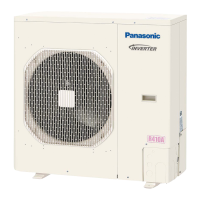

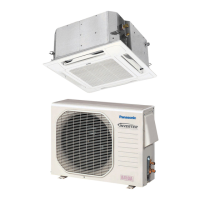




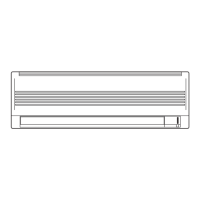
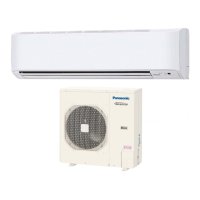

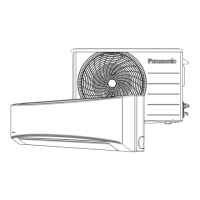

